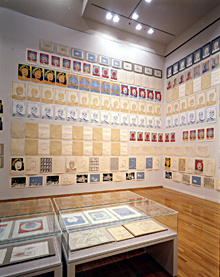4b
日本概念派(2)トリックス・アンド・ヴィジョン
Japanese Conceptualists (2) Tricks and Vision
【本文確定】
本節では広義の日本概念派として、もの派が登場する1969年以前の主知主義的動向を概観します。
一つ目はパフォーマンスの動向です。1965年8月、グループ「位」は岐阜県の長良川畔で巨大な穴を掘り、一定の大きさに達してからまた埋め戻しました。1966年12月、靉嘔ほかによる日本のフルクサスとして、「バス名所観光ハプニング」が東京で行われました。1968年8月、池水慶一や水上旬らのグループ「ザ・プレイ」が和歌山県沖で「VOYAGE」を実施しました。これは外洋で3.3メートルの巨大なポリエステルの卵を黒潮に乗せ放流するというものでした。なおこの動向の裏側には、前述したゼロ次元らの非主知主義的なパフォーマンスがありました。
二つ目はミニマル・アートの紹介です*4b1。ニューヨークで開催された「プライマリー・ストラクチュアズ」展を見た東野芳明は、1966年9月、東京の南画廊で「色彩と空間」展を組織しました。出品者は磯崎新、三木富雄、田中信太郎、山口勝弘ほかで、カタログに掲載された「発注芸術」の語が論議を呼びました。
三つ目は環境芸術です*4b2。これはテクノロジー・アート、ライト・アート、キネティック・アートを含み、のちの1970年の大阪万博(日本万国博覧会 EXPO ’70)では政界や産業界の庇護を受け「万博芸術」の中核を担った動向です*4b3。東京銀座の松屋デパートで1966年11月に開催された「空間から環境へ」展には、東野芳明に率いられた前述の「色彩と空間」展の出品者や、実験工房の元メンバー、さらにはデザイン、建築、音楽等の諸分野から「エンバイラメントの会」の総勢38名が出品しました。その後、エレクトロニクス技術を駆使した展覧会が、海外の同様の動向と歩調を合わせ数多く開催されました。ネオ・ダダからポップ・アートに移行した作家たちも、多くがこの動向に与しました。
四つ目はトリック・アートの動向です*4b4。1968年4月、評論家の中原佑介と石子順造が企画した「トリックス・アンド・ヴィジョン:盗まれた眼」展が東京の村松画廊と東京画廊で開催されました。出品者は、柏原えつとむ、奥田善巳、関根伸夫、鈴木慶則、高松次郎ほかでした。もの派と作家の重複があるにもかかわらず、本展は、1969年にもの派が登場する直前の主知主義的動向をよく表していたと伝えられています。
本展出品者で元ハイレッド・センターのメンバー、高松次郎がこの動向を牽引する存在でした。美術作品の存在論を主知主義的に追求した彼の作品歴は、美術における数の探究として語ることが可能ではないかと私は考えます。初期の「点」「紐」のシリーズは「1」の探究でしたが、不在をテーマとした「影」のシリーズから「0」が始まり、トリック的な「遠近法」、位相幾何学的な「弛み」、言葉を自己言及的に用いた「単語」他が制作されました。1970年、トリック性から離れた「単体」のシリーズで「1」に回帰し、「複合体」では「2」、色彩的な「アンドロメダ」で「多数」に達しましたが、晩年の「形」で三たび「1」に回帰しました。
五つ目として京都概念派と、渡米した作家たちを挙げます。京都の野村仁は1969年の「Tardiology」で、ダンボールを組み合わせた高さ8メートルの塔が展覧会期中に自壊する物質消滅の過程を、プロセス・アートとして呈示しました。狗巻賢二は1969年より糸や針金あるいは紙が空間を軽やかに仕切る、ひそやかでラディカルな作品を作り始めました*4b5。渡米した荒川修作は1964年より「図形絵画」を、河原温は1966年より「日付絵画」を開始しました。
In this section, the intellectualist movement of the Japanese conceptualist school in broad sense of the word before the birth of Mono-ha in 1969 will be discussed.
First is the trend in performances. In August of 1965, the group "I" dug a huge hole by the Nagara River in Gifu Prefecture and buried it after reaching a certain size. In December of 1966, the "Sightseeing on Bus Happening" was carried out in Tokyo by Ay-O and others as part of Fluxus in Japan. In August of 1968, a group called "The Play" whose members included Ikemizu Keiichi and Mizukami Shun carried out an event called "Voyage" off the coast of Wakayama Prefecture. This involved releasing a 3.3 meter diameter egg made out of polyester off the coast on the Japan Current. Behind these trends were tendencies relating to the aforementioned non-intellectualist performances by Zero Jigen.
Second is the introduction of Minimal Art*4b1. After seeing the "Primary Structures" exhibition in New York, Tono Yoshiaki organized "Colors and Space" exhibition at Minami Gallery. The exhibitors included Isozaki Arata, Miki Tomio, Tanaka Shintaro and Yamaguchi Katsuhiro, and the word "Hacchu Geijutsu (Order Made Art)" became the subject of debate.
Third is Environmental Art*4b2. This was an art trend which included technology art, light art and kinetic art and became the core of "Banpaku Geijutsu (Expo Art)" with the backing of political circles and industrial sectors at Japan World Exposition, Osaka in 1970 (EXPO'70)*4b3. At the "From Space to Environment" exhibition held on November 1966 at the Matsuya Department Store in Ginza, Tokyo, a total of 38 exhibitors which included those from the aforementioned "Colors and Space" exhibition organized by Tono, former members of Experiment Workshop and members from "Environment no Kai (The Environment Group)" with backgrounds in design, architecture and music exhibited their works. Later, many exhibitions involving the use of electronics technology were held in line with the same trends happening overseas. There were many of those from Neo Dada to Pop Art who took sides with this trend.
Fourth is a trend called Trick Art*4b4. In April of 1968, an exhibition called "Trick and Vision: The Stolen Eye," organized by Nakahara Yusuke and Ishiko Junzo was held at Muramatsu Gallery and Tokyo Gallery. Exhibitors included Kashihara Etsutomu, Okuda Yoshimi, Sekine Nobuo, Suzuki Yoshinori and Takamatsu Jiro, and although the names of the exhibitors and names of the Mono-ha members overlap, the exhibition shows a trend towards intellectualism before the emergence of Mono-ha.
Takamatsu, who was one of the exhibitors, was the leader towards this trend. His works, which investigated the ontology of his own works, can be described as an investigation into numbers in art. The earlier series "Point" and "String" had '1' as a theme, but from "Shadow" series which expressed non-existence, they had '0' as a theme. The contents of his works developed from 1966 with the deceptive "Perspective" series and the topological "Slack" series from 1968, and onto conceptual art which utilized languages and letters as self-reference. For example, the 1970 work "English Words" had the words "THESE THREE WORDS" printed on a paper, and "THESE THREE WORDS" referred to the words "THESE," "THREE" and "WORDS." From 1970, he parted with the deceptiveness of his works and went back to doing '1' which became the theme of the "Oneness" series, and was followed by "Compound" series with '2' as a theme and in later years, the color paintings called "Form" had 'multiple numbers' as a theme.
Fifth is the Kyoto Conceptualist School and those who went overseas. Nomura Hitoshi from Kyoto presented the process of material disappearance in which an 8 meter tall tower made out of cardboards collapsed during the 1969 "Tardiology" exhibition as Process Art. From 1969, Inumaki Kenji created modest yet radical works where strings, wires or papers gently partition a space*4b5. One of those who went overseas, Arakawa Shusaku, started diagrammatic works from 1964, and Kawara On started "Date Paintings" from 1966.

